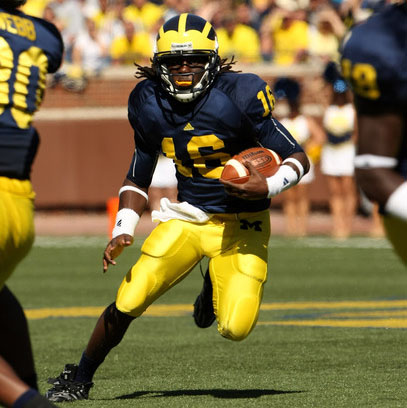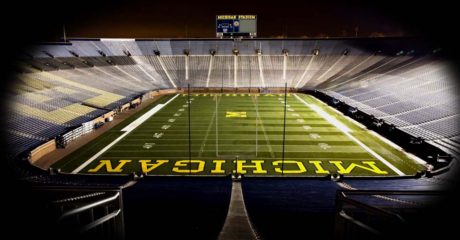Review of 2010 Season Predictions
 |
| Denard Robinson was the star of the show in 2010 |
One of the reasons I started this blog a couple years ago was to record my thoughts and predictions in order to go back, see what I said, and see if I was right. With the 2010 season completed, I thought I would go back and check out what I said prior to the year beginning.
First of all, here were my 2010 Season Predictions.
And here’s a rundown of how accurate those were:
STARTING QUARTERBACK
Prediction: I said Denard Robinson would start the opener but that Tate Forcier would have an opportunity to take most of the snaps by the end of the season.
Actual: Denard Robinson started the entire season.
Accuracy: 50%
LEADING RUSHER
Prediction: Denard Robinson with approximately 800 yards.
Actual: Well, I was right on the player, but wrong on the yardage. Way wrong. Robinson ended up wtih 1,702 yards on the ground.
Accuracy: 100%
LEADING RECEIVER
Prediction: Roy Roundtree with 60 catches for 900 yards
Actual: Roundtree had 72 catches for 935 yards.
Accuracy: 100%
LEADING TACKLER
Prediction: Jonas Mouton
Actual: Mouton led the team with 117 tackles, beating out safety Jordan Kovacs by a slim margin.
Accuracy: 100%
LEADING SACKER
Prediction: Ryan Van Bergen with 7.5 sacks
Actual: Van Bergen led the team in sacks, but it was a down year in that category – he ended up with only 4.
Accuracy: 100%
LEADING INTERCEPTOR
Prediction: J.T. Floyd
Actual: Cornerback James Rogers and safety/linebacker Cam Gordon each had 3. Floyd only had 1, but he missed half the season with a broken ankle.
Accuracy: Incomplete due to Floyd’s injury
ALL-BIG TEN FIRST TEAM
Prediction: Center David Molk and kick returner Darryl Stonum
Actual: Molk was the right choice. However, the coaches decided to save Stonum for his offensive duties, giving the job to a couple mediocre returners instead. With a surprisingly good season, Denard Robinson was also named to the first team by the media.
Accuracy: 33%
LEADING SCORER (NON-KICKER, NON-QUARTERBACK)
Prediction: Roy Roundtree
Actual: Running back Michael Shaw scored 9 touchdowns to lead this category. Roundtree and running back Vincent Smith were second with 7 touchdowns each.
Accuracy: 0%
BREAKOUT OFFENSIVE PLAYER
Prediction: Denard Robinson
Actual: Robinson was definitely the breakout player of the year on offense. He was in the discussion for the Heisman, was the Big Ten Player of the Year, and generally wowed Michigan fans and college football fans in general.
Accuracy: 100%
BREAKOUT DEFENSIVE PLAYER
Prediction: Ryan Van Bergen
Actual: Well, nobody really expected much from the defense, and that’s what they got – not much. Van Bergen had a decent season with 37 tackles, 8.5 tackles for loss, and 4 sacks. But I think the real breakout star was middle linebacker Kenny Demens, who surpassed incumbent Obi Ezeh and finished third on the team with 82 tackles.
Accuracy: 0%
MOST DISAPPOINTING OFFENSIVE PLAYER
Prediction: Vincent Smith
Actual: I don’t think it’s a stretch to say that Smith was somewhat less effective than is expected from a starting tailback at Michigan. He finished the year averaging 4.4 yards per carry and – other than a long run against Indiana – was generally ineffective as a complementary runner to quarterback Denard Robinson. Roundtree might be an option here because of his play in the final few games of the season, but Smith was ineffective for the majority of the season.
Accuracy: 100%
MOST DISAPPOINTING DEFENSIVE PLAYER
Prediction: Cameron Gordon
Actual: While Gordon was a disappointment after all the hype he received in the spring and summer, he wasn’t a complete failure. He actually made some plays from the free safety position (3 interceptions), but he didn’t have the speed or awareness to stay there and moved to outside linebacker. But the bigger disappointment was Obi Ezeh, the fifth-year senior middle linebacker who lost his job mid-season to redshirt sophomore Kenny Demens. Ezeh ended the year with 58 tackles, which is exactly 24 fewer than Demens . . . and 8 fewer than J.T. Floyd, the cornerback who missed half the season with a broken ankle.
Accuracy: 0%
GAME PREDICTIONS
Win against UConn
Loss to Notre Dame
Win against UMass
Win against Bowling Green
Loss to Indiana
Loss to Michigan State
Win against Iowa
Win against Penn State
Win against Illinois
Win against Purdue
Loss to Wisconsin
Loss to Ohio State
OVERALL PREDICTION ACCURACY:
63.9%





